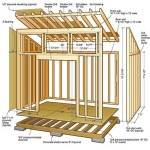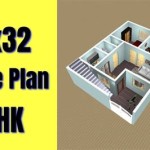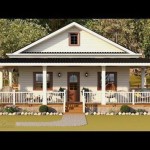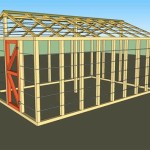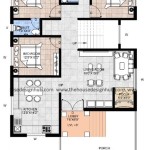Rectangle House Floor Plans refer to architectural designs that feature houses with a rectangular footprint. These plans are widely used in residential construction due to their simplicity, functionality, and cost-effectiveness. A prominent example of a rectangular house floor plan is the classic ranch-style home, known for its long, rectangular shape and open concept living spaces.
The rectangular shape of these floor plans provides numerous advantages. It allows for efficient space utilization, maximizing the available square footage. Additionally, rectangular house plans facilitate the creation of open and flowing floor plans, promoting natural light and air circulation. Their straightforward design also simplifies construction processes, resulting in reduced building costs and shorter construction times.
In the following sections, we will delve deeper into the key features, benefits, and considerations associated with rectangle house floor plans. We will explore their suitability for different lifestyles, lot sizes, and architectural styles, providing insights into their versatility and adaptability.
Rectangle house floor plans offer a range of notable benefits, including:
- Efficient space utilization
- Open and flowing floor plans
- Simplified construction processes
- Cost-effectiveness
- Versatility in design
- Adaptability to various lot sizes
- Enhanced natural light and ventilation
- Suitable for different lifestyles
These advantages make rectangle house floor plans a popular choice for homeowners seeking practical, functional, and aesthetically pleasing living spaces.
Efficient space utilization
Rectangle house floor plans excel in efficient space utilization, maximizing the available square footage and minimizing wasted space. The rectangular shape allows for a logical and organized arrangement of rooms, with minimal hallways and corridors.
- Optimized room placement: The rectangular footprint enables architects to optimize the placement of rooms, ensuring that each space has adequate natural light and ventilation. This thoughtful arrangement minimizes the need for artificial lighting and heating/cooling systems, reducing energy consumption.
- Reduced hallways and corridors: Unlike more complex floor plans, rectangle house designs typically require fewer hallways and corridors. This reduces wasted space and increases the usable area within the home, allowing for more spacious and functional rooms.
- Efficient furniture placement: The rectangular shape of the rooms facilitates efficient furniture placement. Furniture can be arranged along the walls, maximizing the central floor space and creating a sense of openness and flow.
- Multifunctional spaces: Rectangular floor plans lend themselves well to the creation of multifunctional spaces. Open-concept living areas, for example, combine multiple functions such as living, dining, and cooking into a single, cohesive space, maximizing space utilization.
Overall, the efficient space utilization offered by rectangle house floor plans translates into homes that feel more spacious, comfortable, and functional, while minimizing wasted space and maximizing the value of every square foot.
Open and flowing floor plans
Rectangle house floor plans are renowned for their ability to create open and flowing floor plans, characterized by a seamless transition between different living spaces. This design approach fosters a sense of spaciousness, promotes natural light penetration, and encourages interaction among family members and guests.
The rectangular shape of the house allows for the creation of large, open-concept living areas. By eliminating unnecessary walls and partitions, these floor plans seamlessly connect the living room, dining room, and kitchen into a single, cohesive space. This open layout promotes a sense of spaciousness and togetherness, making it ideal for families and individuals who enjoy entertaining.
Open floor plans also facilitate the flow of natural light throughout the home. With fewer walls obstructing the path of sunlight, natural light can penetrate deep into the interior spaces, reducing the reliance on artificial lighting. This creates a brighter, more inviting, and energy-efficient living environment.
Furthermore, open and flowing floor plans promote interaction and communication among family members. The absence of physical barriers allows for easy movement and sightlines between different living areas. This encourages family members to spend more time together, fostering a sense of connection and belonging.
Overall, the open and flowing floor plans associated with rectangle house designs contribute to a more spacious, well-lit, and socially interactive living environment.
Simplified construction processes
Rectangle house floor plans are not only functional and efficient but also offer simplified construction processes, contributing to reduced building costs and shorter construction times.
- Fewer complex angles: Unlike houses with more intricate shapes, rectangular houses require fewer complex angles and cuts during construction. This simplifies the framing process, reducing the need for specialized tools and techniques, and minimizing the risk of errors.
- Straightforward rooflines: Rectangle houses typically feature simple, gable or hip rooflines, which are easier to construct compared to more complex roof designs. This reduces the time and labor required for roofing, resulting in faster construction and lower costs.
- Efficient material usage: The rectangular shape of the house allows for efficient material usage, minimizing waste and optimizing material costs. Standard-sized building materials can be utilized effectively, reducing the need for custom cuts and minimizing material expenses.
- Faster framing: The straightforward layout of rectangle house floor plans enables faster framing, as walls and partitions can be easily aligned and erected. This reduces the overall construction time, allowing the project to be completed more quickly and efficiently.
Overall, the simplified construction processes associated with rectangle house floor plans contribute to reduced costs, shorter construction times, and a more streamlined building process.
Cost-effectiveness
Rectangle house floor plans are not only practical and efficient but also offer significant cost-effectiveness compared to more complex house designs.
- Reduced material costs: The rectangular shape of the house minimizes the exterior wall surface area, reducing the amount of materials required for construction. This translates into lower costs for materials such as siding, roofing, and insulation.
- Simplified foundation: Rectangle houses typically require a simpler foundation design due to their symmetrical shape and evenly distributed weight. This reduces excavation and concrete work, resulting in lower foundation costs.
- Efficient framing: The straightforward layout of rectangle house floor plans simplifies the framing process, reducing labor costs and minimizing the need for specialized framing techniques.
- Shorter construction time: The simplified design and construction processes associated with rectangle house floor plans allow for faster construction times. This reduces labor costs and overhead expenses, contributing to overall cost-effectiveness.
Overall, the cost-effectiveness of rectangle house floor plans makes them an attractive option for homeowners looking to build a practical and affordable home without compromising on functionality or aesthetics.
Versatility in design
Rectangle house floor plans offer remarkable versatility in design, allowing for a wide range of architectural styles and customization options to suit diverse tastes and preferences. The rectangular shape provides a flexible canvas upon which architects and homeowners can create unique and personalized living spaces.
One key aspect of the versatility of rectangle house floor plans lies in their adaptability to various lot sizes and shapes. The rectangular shape can be easily adjusted in terms of length and width to fit different lot dimensions, maximizing space utilization and ensuring a harmonious relationship between the house and its surroundings.
Furthermore, rectangle house floor plans lend themselves well to both traditional and contemporary architectural styles. The simple, clean lines of the rectangular shape complement both classic and modern design aesthetics. Whether it’s a charming Craftsman bungalow, a sleek mid-century modern home, or a contemporary farmhouse, the rectangular floor plan provides a solid foundation for a variety of architectural expressions.
Additionally, rectangle house floor plans offer flexibility in interior layout and room configuration. The open and flowing nature of the rectangular shape allows for creative room arrangements, accommodating different lifestyles and functional requirements. Whether it’s a cozy family home with separate living spaces or an open-concept design for entertaining, the rectangular floor plan provides the adaptability to create spaces that meet specific needs and preferences.
Overall, the versatility in design offered by rectangle house floor plans empowers homeowners to create unique and personalized living spaces that reflect their individual tastes, lifestyles, and architectural preferences.
Adaptability to various lot sizes
Rectangle house floor plans excel in their adaptability to various lot sizes, making them a suitable choice for a wide range of properties. The rectangular shape can be easily adjusted in terms of length and width to fit different lot dimensions, ensuring efficient space utilization and a harmonious relationship between the house and its surroundings.
For narrow or elongated lots, a rectangular house plan can be oriented lengthwise to maximize the usable space. This approach ensures that the house fits comfortably on the lot while leaving sufficient space for outdoor areas such as gardens, patios, or driveways.
On wider lots, a rectangular house plan can be oriented perpendicular to the street, creating a more traditional front-facing design. This orientation provides ample space for a front yard, a backyard, and potentially side yards, allowing for a variety of outdoor activities and landscaping options.
Additionally, rectangle house floor plans can be adapted to accommodate challenging lot shapes. For example, a pie-shaped lot can be accommodated by designing a house with an angled or curved rear wall. This ensures that the house fits snugly on the lot while maximizing the usable space and minimizing wasted areas.
Overall, the adaptability of rectangle house floor plans to various lot sizes provides homeowners with the flexibility to create custom homes that meet their specific needs and preferences, regardless of the lot constraints.
Enhanced natural light and ventilation
Rectangle house floor plans are designed to maximize natural light and ventilation, creating a healthier and more comfortable living environment. The rectangular shape allows for the strategic placement of windows and doors to capture sunlight from different angles throughout the day.
Large windows and sliding glass doors are commonly incorporated into the design, allowing natural light to penetrate deep into the interior spaces. This reduces the reliance on artificial lighting, creating a brighter and more inviting atmosphere. Additionally, strategically placed windows promote cross-ventilation, allowing fresh air to circulate naturally through the house, reducing the need for air conditioning and improving indoor air quality.
The open and flowing floor plans associated with rectangle house designs further enhance natural light and ventilation. By eliminating unnecessary walls and partitions, these floor plans create a seamless connection between different living areas, allowing natural light to penetrate from one space to another. This openness also facilitates the movement of air, ensuring that all areas of the house are well-ventilated.
Furthermore, the rectangular shape of the house allows for the incorporation of skylights and clerestory windows. Skylights provide a direct source of natural light from above, illuminating interior spaces that may not have access to direct sunlight from windows. Clerestory windows are high windows placed near the ceiling, which allow natural light to enter while maintaining privacy and reducing heat gain.
Overall, the enhanced natural light and ventilation offered by rectangle house floor plans contribute to a healthier, more comfortable, and energy-efficient living environment.
Suitable for different lifestyles
Rectangle house floor plans are suitable for a wide range of lifestyles and family dynamics, offering flexibility and adaptability to meet diverse needs and preferences.
- Families with children:
Rectangle house floor plans provide ample space for families with children. The open and flowing layout allows for easy supervision of children, while the separate bedrooms provide privacy and dedicated spaces for each family member. Additionally, the rectangular shape can accommodate a backyard or play area, providing children with outdoor space for recreation and entertainment.
- Empty nesters and retirees:
Rectangle house floor plans are well-suited for empty nesters and retirees who desire a comfortable and manageable home. The single-story layout often associated with rectangle house designs eliminates the need for stairs, making it easier to navigate for individuals with mobility concerns. Additionally, the open and flowing floor plan provides a sense of spaciousness and reduces the feeling of isolation that can sometimes accompany empty nest syndrome.
- Couples and singles:
Rectangle house floor plans offer a cozy and efficient living space for couples and singles. The open and flowing layout creates a sense of spaciousness, while the efficient use of space minimizes maintenance and upkeep. Additionally, the rectangular shape allows for the creation of dedicated areas for work, relaxation, and entertainment, providing a comfortable and functional home for individuals or couples.
- Multi-generational families:
Rectangle house floor plans can be adapted to accommodate multi-generational families. By incorporating separate living quarters or in-law suites, these floor plans provide privacy and independence for older family members while maintaining a sense of togetherness. The open and flowing layout facilitates interaction and communication between family members, fostering a strong sense of community and support.
Overall, the flexibility and adaptability of rectangle house floor plans make them suitable for a wide range of lifestyles and family dynamics, providing comfortable and functional living spaces that meet the diverse needs of homeowners.
![[21+] Stylishly Floor Plan 2 Story Rectangle That So Artsy Narrow](https://i1.wp.com/i.pinimg.com/originals/cd/a1/55/cda155912ee362115fffa75b131683c3.jpg)









Related Posts

